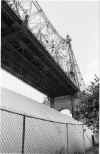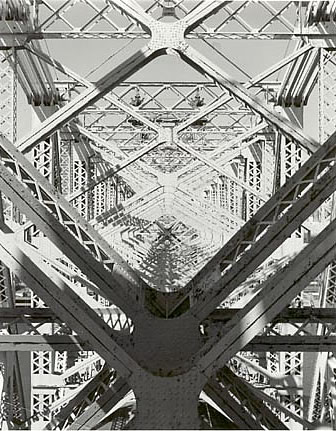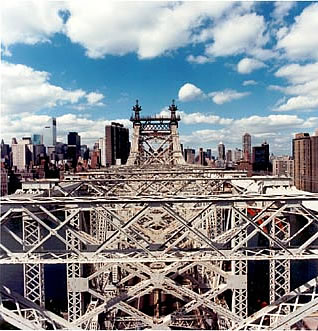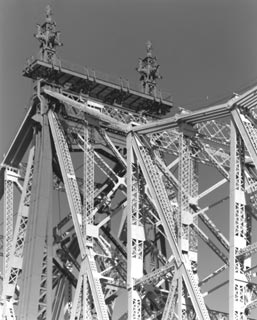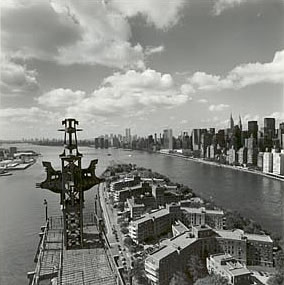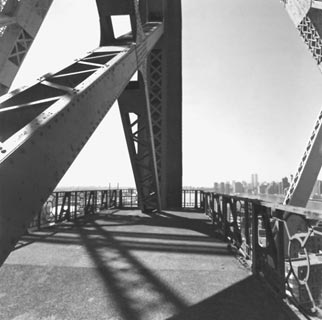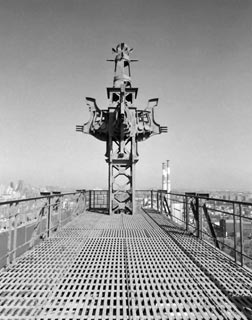|
The Queensboro Bridge, also known as the 59th Street
Bridge, is a cantilever bridge over the East River in New York City that
was completed in 1909. It connects the neighborhood of Long Island City
in the borough of Queens with Manhattan, passing over Roosevelt Island.
It carries New York State Route 25 and once carried NY 24 and NY 25A as
well.
The Queensboro Bridge is the westernmost of the four East River spans
that carry a route number: NY 25 terminates at the west (Manhattan) side
of the bridge. It is commonly called the "59th Street Bridge" by New
York City residents because its Manhattan end is located between 59th
and 60th Streets.
History
Serious proposals for a bridge linking Manhattan to Long Island City
were first made as early as 1838 and attempts to finance such a bridge
were made by a private company beginning in 1867. Its efforts never came
to fruition and the company went bankrupt in the 1890s. Successful plans
finally came about in 1903 under the city's new Department of Bridges,
led by Gustav Lindenthal in collaboration with Leffert L. Buck and Henry
Hornbostel, designers of the Williamsburg Bridge. Construction soon
began but it would take until 1909 for the bridge to be completed due to
delays from the collapse of an incomplete span during a windstorm and
from labor unrest (including an attempt to dynamite one span). The
bridge opened to the public on March 30, 1909, having cost about $18
million and 50 lives. It was then known as the Blackwell's Island
Bridge, from an earlier name for Roosevelt Island. Between 1930 and
1955, there was a vehicular elevator to transport cars and passengers to
and from Welfare Island, now known as Roosevelt Island. This was
demolished in 1970.
The bridge has two levels. Originally the top level contained two
pedestrian walks and two elevated railway tracks (as a spur from the IRT
Second Avenue Elevated Line) and the lower deck four motor traffic
lanes, and what is now the "outer roadway" and pedestrian walk were two
trolley lanes. There was a trolley stop in the middle of the bridge for
access to Roosevelt Island. Passengers using the mid-bridge station
would transfer to a structure built along side the bridge containing
elevators down to street level. The railway would be removed in the late
1930s and early 1940s as well as the 2nd Avenue Elevated Line. The
trolley lanes and mid-bridge station were removed in the 1950s, and for
the next few decades the bridge carried 11 lanes of automobile traffic.
No tolls are charged for motor vehicles to use the bridge.
The bridge was known as the 59th Street Bridge before WWII.
Today
After years of decay and corrosion, an extensive renovation of the
Queensboro Bridge was begun in 1987 and is still in progress, having
cost over $300 million.
The upper level of the Queensboro Bridge has four lanes of automobile
traffic and provides an excellent view of the bridge's cantilever truss
structure and the New York skyline. The lower level has six lanes, the
inner four for automobile traffic and the outer two for either
automobile traffic or pedestrians and bicycles. The North Outer Roadway
was converted into a permanent pedestrian walk and bicycle path in 1999.
The Manhattan approach to the bridge is supported on a series of
Guastavino tile vaults which now form the elegant ceiling of the Food
Emporium and the restaurant Guastavino's, located under the bridge.
Originally, this open air promenade was known as Bridgemarket and was
part of Hornbostel's attempt to make the bridge more hospitable in the
city.
[edit] Rail tracks
In addition to the two rapid transit tracks, the bridge also had four
streetcar tracks. The following Queens lines operated over the bridge:
Queensboro Bridge Local, 1909-1957 (last streetcar line in the city)
Astoria Line, 1910-1939
Steinway Line, 1910-1939
Queens Boulevard Line, 1913-1937
College Point Line, 1910-1925
Corona Line, 1910-1922
One Manhattan line operated over the bridge, the Third Avenue Railway's
42nd Street Crosstown Line from 1910 to 1919.
[edit] In popular culture
In F. Scott Fitzgerald's novel The Great Gatsby, Jay Gatsby and Nick
Carraway traverse the bridge on their way from Long Island to Manhattan.
"The city seen from the Queensboro Bridge," Nick says, "is always the
city seen for the first time, in its first wild promise of all the
mystery and the beauty in the world".
Bridge circa 1908In the novel Charlotte's Web, Charlotte refers to the
Queensboro Bridge as a sort of human-made spider web.
The bridge is featured (as the 59th Street Bridge) in the title of the
Simon and Garfunkel song The 59th Street Bridge Song (Feelin' Groovy).
The Queensboro is prominently displayed during the opening credits of
the television series Taxi, as a cab (driven by series star Tony Danza)
drives across it.
The bridge is the setting for a significant scene in the 2002 movie
Spider-Man. In that movie, the Green Goblin throws Mary Jane Watson from
the bridge, and Spider-Man must decide between saving her or passengers
on the Roosevelt Island tram.
In Ultimate Spider-Man #25, the Green Goblin kidnaps Mary Jane Watson
and throws her off the bridge.
The Queensboro Bridge is prominently displayed in anime Red Garden, even
sustaining extensive damages due to a battle.
The theme song of the CBS sitcom The King of Queens include the lyrics
"Sitting here in traffic on the Queensboro Bridge tonight."
The Queensboro Bridge was used in the thrill ride Kongfrontation at
Universal Studios Florida. The ride, based on King Kong, had passengers
riding the Roosevelt Island Tramway from Manhattan to Roosevelt Island.
A mechanical King Kong attacked the cars while hanging off the
Queensboro Bridge.
The 59th Street Bridge was blasted by supervillain Hank Scorpio in The
Simpsons episode "You Only Move Twice", in a plot to blackmail the UN.
The Queensboro Bridge plays a key role in the opening and chase
sequences in King of New York.
In 1992's Home Alone 2: Lost in New York, a taxi drives Kevin
McCallister Macaulay Culkin across the upper deck of the bridge.
The bridge was featured in the 1981 John Carpenter film Escape from New
York. The bridge was one of the last intact links to the Manhattan
Island prison and was land mined to thwart escape attempts.
An iconic shot of the bridge in Woody Allen's Manhattan (1979).The
bridge is seen in the Woody Allen film Manhattan in an iconic visual.
The opening sequence to the animated TV show The Critic recreates the
aforementioned Manhattan scene, with the bridge collapsing in the river
for comic effect.
The opening sequence in the film New Jack City is set on the bridge, in
which Wesley Snipes' character throws a rival off to his death.
Musician David Mead included a song called "Queensboro Bridge" on his
2004 album Indiana.
The Queensboro Bridge was featured in the opening and closing credits of
Archie Bunker's Place.
On the album Stillmatic by Queensbridge rapper Nas, the inner-lining
features the bridge on many pictures.
Frequently seen in the background from a patio on which episodes of the
Food Network show "Boy Meets Grill" featuring NYC chef Bobby Flay are
filmed.
In The Game's song "300 Bars and Runnin'" these lyrics are featured: "He
got G-Unit wings, throw them off the Queens Bridge"
The Queensboro Bridge was featured in the movie "Turk 182". Graffiti
artist, Turk 182 (Jimmy Lynch) played by Timothy Hutton climbs the
Queensboro Bridge and spells his tag "Turk 182" in lights.
The Queensboro Bridge lies along the 16th mile of the New York City
Marathon race. The long, relatively steep approach climb is considered a
pivotal point of the route, causing many runners severe fatigue.
|
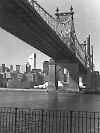
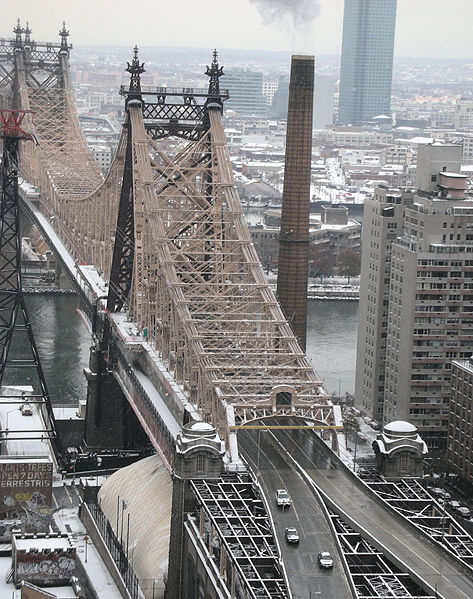
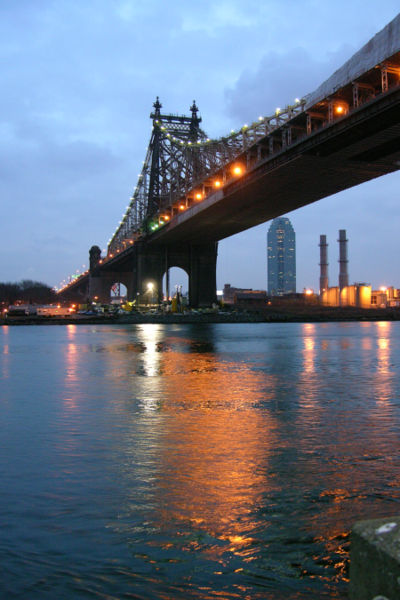
.jpg)
.jpg)




